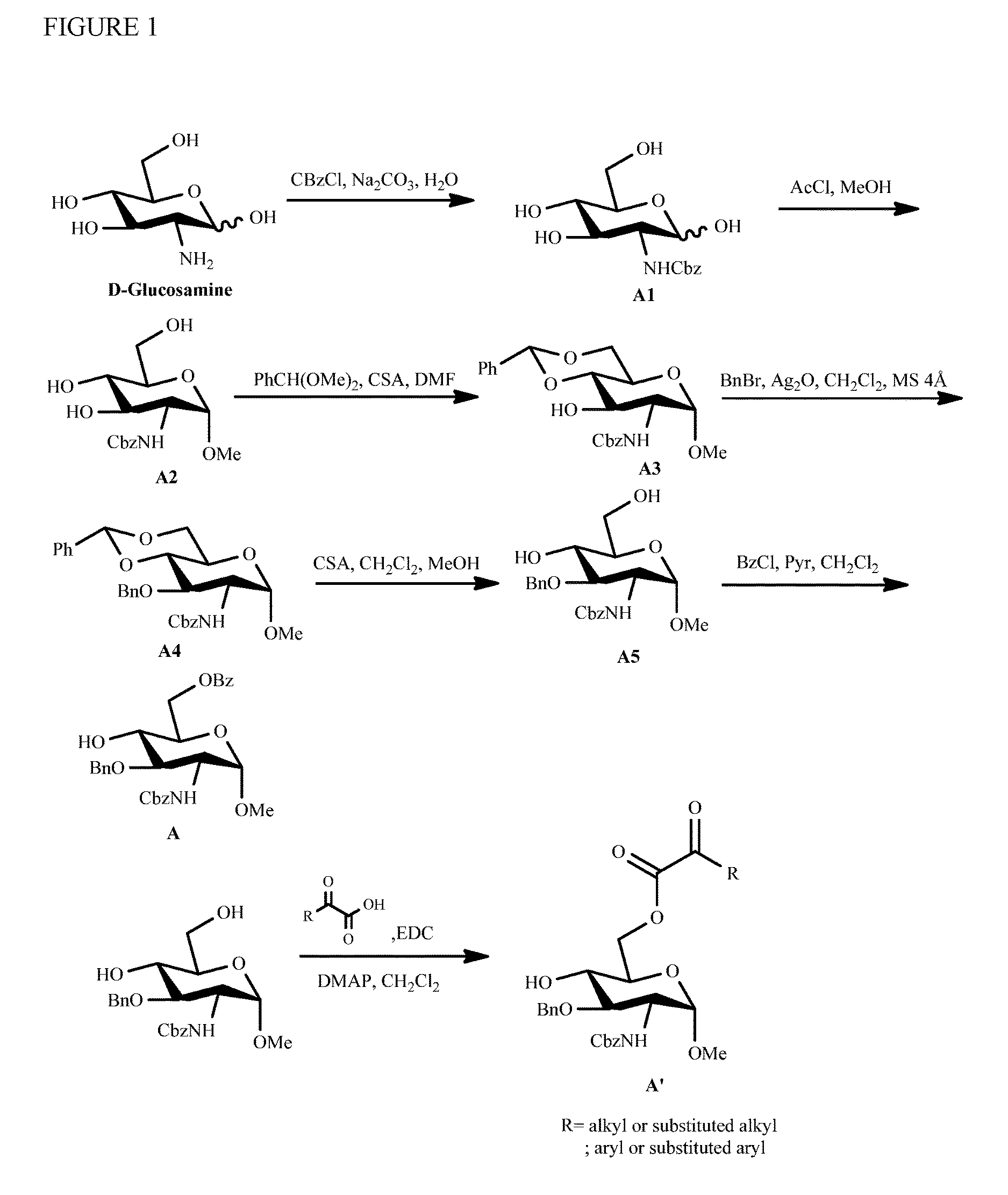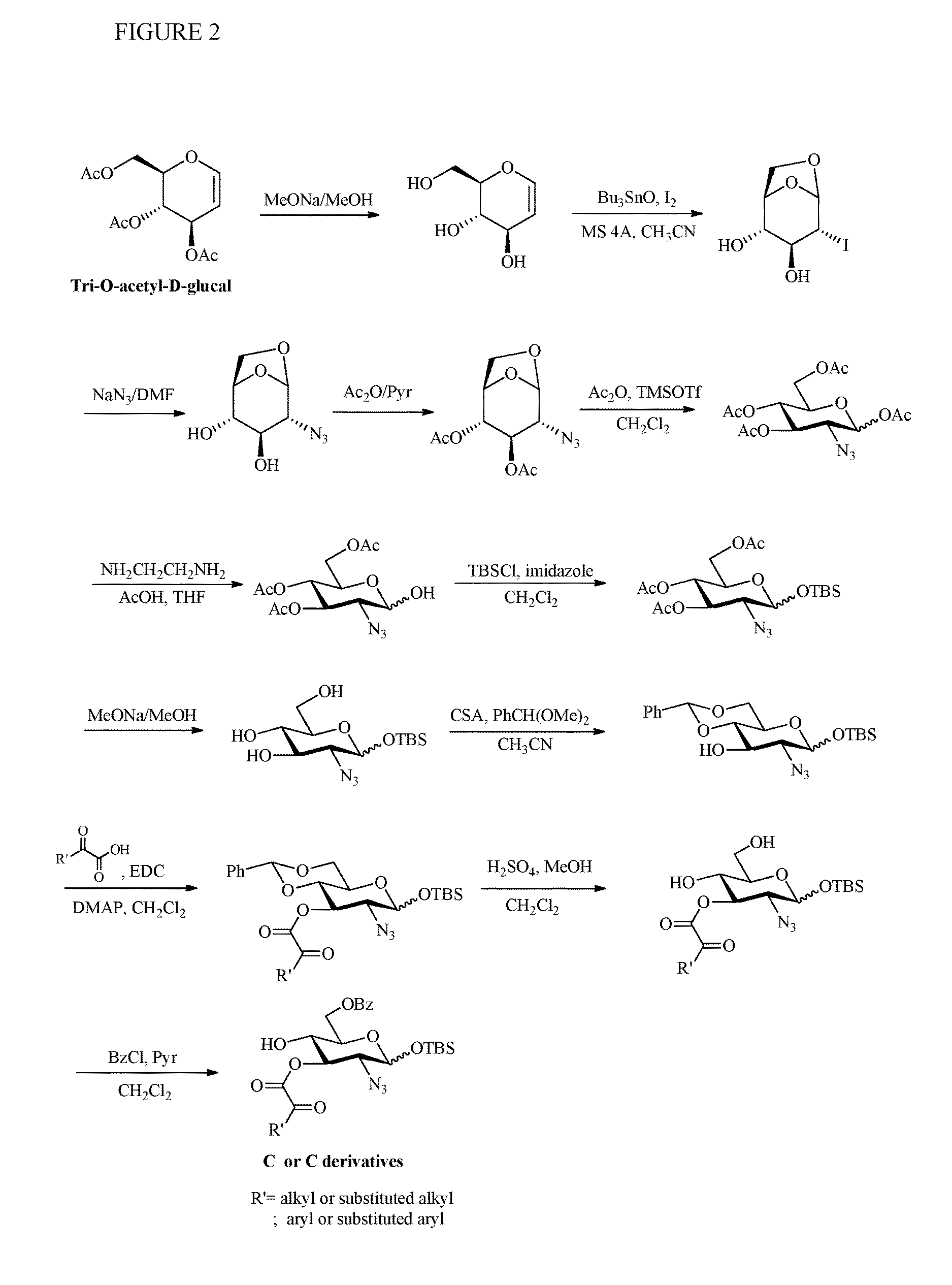Preparation of monosaccharides, disaccharides, trisaccharides, and pentasaccharides of heparinoids
a technology of heparinoids and monosaccharides, applied in the field of preparation of monosaccharides, disaccharides, trisaccharides, and pentasaccharides of heparinoids, can solve the problems of large amount of organic solvent and time required for reaction, significant difficulties in both reported syntheses, and inflammation and pulmonary emboli
- Summary
- Abstract
- Description
- Claims
- Application Information
AI Technical Summary
Benefits of technology
Problems solved by technology
Method used
Image
Examples
example 1
Preparation of Monosaccharide E
[0108]Step 1. Formation of Monosaccharide E-4
[0109]Tetrahydrofuran (THF)(550 ml), E-3 (C-3) were added to the reaction flask. Potassium hydroxide, benzyl bromide (BnBr) were added and stirred, heated to 65° C. for reflux. The white powder formed during reaction occurred. The reaction mixture was kept stirring under reflux until completion checked by TLC and UPLC. Sodium thiosulfate(sat) aqueous solution (30 ml), water (200 ml and Ethylacetate (200 ml) were added to the solution and stirred for 20 min, then stand for 20 min. the solution was separation into two layers. Collect the ethylacetate layer. Add water (250 ml) to ethylacetate layer and stirred for 20 min. discard the aqueous layer, then aqueous sodium chloride(sat) (200 ml) solution was added for extraction. Discard the aqueous layer, then extracted with aqueous sodium chloride(sat) (200 ml) solution. Collect all ethylacetate solutions and added MgSO4 (28 g) for 30 min to absorb water. Filtered...
example 2
Preparation of Monosaccharide D
[0122]Step 1. Formation of Monosaccharide D-1
[0123]Ethylacetate (1000 ml) was added to the reaction flask. D-glucose (200 g) was added, then 98% sulfuric acid (6 ml) in ethylacetate was added to the reaction mixture. The solution was cooled to 5˜10° C. with ice bath, acetic anhydride (620 ml) was dropwisely added. After the addition, the solution was heated to 20˜25° C., then to 50˜55° C., the solution turn clear. The reaction extent is checked by TLC (DCM / MeOH=3 / 1) until completion. 10% NaOH aqueous solution (300 ml) was added to quench the reaction and the temperature was controlled at 15˜20° C. during the addition. 7% brine solution (200 ml) was added and stirred for 20 min, then stand for 20 min. 7% brine solution (500 ml) was added to organic layer and stirred for 20 min, then stand for 20 min again. Saturated sodium bicarbonate was added to organic layer nd stirred for 20 min, then stand for 20 min. The organic layer was dried over MgSO4, then ev...
example 3
Preparation of Monosaccharide C
[0139]Step 1. Formation of Monosaccharide C-1
[0140]Methanol (800 ml) was added to the reaction flask. Tri-Oacetyl-D-glucal (200 g), sodium methoxide (1.98 g) was adde and stirred for 30 min. The reaction mixture was checked by TLC (EA) until completion. The mixture was neutralized with Amberlite IR 120 ion exchange resin (acid form, 20 g) until pH 7.0. AmberliteIR 120 ion exchange resin was recovered by suction filtration and washed with methanol (200 ml).
[0141]The mixture was concentrated under vacuum, the viscous oily liquid, E-1 was obtained.
[0142]Step 2. Formation of Monosaccharide C-2
[0143]Acetonitrile (200 ml) was added the reaction flask containing viscous oily E-1 and stirred for about 20 min until the reaction mixture become clear, then molecular sieve 4A (21.5 g), acetonitrile (1500 ml) were added. The mixture was heated to 55° C.
[0144]The sample was taken for determination of water content by KF titration (KF NMT 0.05%). Cool the reaction so...
PUM
| Property | Measurement | Unit |
|---|---|---|
| temperature | aaaaa | aaaaa |
| temperature | aaaaa | aaaaa |
| temperature | aaaaa | aaaaa |
Abstract
Description
Claims
Application Information
 Login to View More
Login to View More - R&D
- Intellectual Property
- Life Sciences
- Materials
- Tech Scout
- Unparalleled Data Quality
- Higher Quality Content
- 60% Fewer Hallucinations
Browse by: Latest US Patents, China's latest patents, Technical Efficacy Thesaurus, Application Domain, Technology Topic, Popular Technical Reports.
© 2025 PatSnap. All rights reserved.Legal|Privacy policy|Modern Slavery Act Transparency Statement|Sitemap|About US| Contact US: help@patsnap.com



